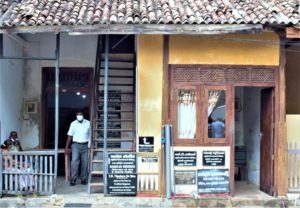It’s easy to understand why the Sri Lankan city of Galle is a UNESCO World Heritage site: built by the Dutch from 1663 onwards, many colonial buildings still exist within the fort walls.
Walking the walls is the number 1 ‘must do’, and can take around 2 hours depending on how often you stop to admire the views. There are 14 fortified positions known as ‘bastions’ and at each were marble headstones with information in three languages, Sinhalese, Tamil and English. There is a good guide to the various bastions on the website of the Aqua Forte restaurant.
On the north wall, were the Sun, Moon and Star bastions with full size metal statues of soldiers and slaves. Here we had good views of the international cricket ground and knowing how passionate Sri Lankans are about cricket, were surprised to discover their national sport is volleyball, although cricket is the most popular. The ground was previously a horseracing track and before that, the Gymkhana Club during British rule. A white pavilion, said to contravene planning regulations because it obscured views of the fort from town, was named after Mahinda Rajapaksa the Prime Minister.
At Flag Rock Bastion, on the southern section, teenagers dive into the water for money: this looked dangerous bearing in mind the number of rocks. This area is also a great vantage point for sunset at around 6.30pm.
Walking the walls gave us the chance to see the new lighthouse built in 1938 and the site of the old one, as well as numerous cannon and munition storage areas.
Whether you do a complete circuit of the walls, or walk sections, it’s a great experience especially in the early morning or late afternoon when its cooler.
It was then time to explore the narrow streets inside the fort. We started at the National Maritime Museum, although we didn’t go in, and the Old Gate with a beautifully carved British coat of arms on one side, and on the other the letters VOC (Vereenigde Oostindische Compagnie or Dutch East India Company) flanked by two lions and topped by a cockerel.
We passed the Court House and several offices belonging to lawyers and notaries, where we could hear the clacking of old-fashioned typewriters: all legal documents are typed rather than produced on a PC to prevent alteration.
94% of the population are Buddhists, but near the gleaming white stupa, was the grand white Meran Mosque. We also saw Catholic and Methodist churches and were told the religions get on well. Unsurprisingly because of the heritage, we also found and popped into the All-Saints Anglican Church, and the Dutch Reformed Church, with its floor paved with gravestones and pulpit topped with a striking large hexagonal canopy.
Other legacies of the Dutch period were an intricate sewer system, flushed daily by the tide, and the old Dutch Hospital, said to be full of upmarket boutiques, but probably because of Covid, was sadly a little empty, although some bars, restaurants and gemstone shops were trading. In fact gemstone shops are prevalent in the city, but sadly the two shops I wanted to visit, Chilli Dragon Spice Shop and the brilliantly named Mr Ellie Pooh’s Poo Poo Paper Shop, were both victims of Covid.












